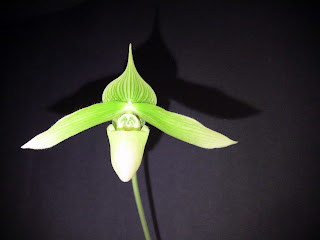 |
| Early morning pollination |
DEET doesn't smell like victory, but it allows me to leave the daylily garden without a ghastly array of chigger and mosquito bites. It's important for me to be outside during the summer months for at least two to three hours a day. The early morning is ideal. I collect daylily pollen, make crosses, water the orchids, take a few bird photos, and settle into work. Forgive me for talking about the weather, but the Midwest summer morning always seems like it's going to last longer than it does. For instance, it's a lovely 83 degrees right now and, although I know it's going to surpass 100 today, the perfection feels like it could last forever. Why wouldn't it?
 |
| 'Beautiful Edgings' (Copenhaver 1989) |
The extreme weather hurts the viability of my daylily crosses, but there's not much I can do. I made about twenty today and I will be happy if one or two set seed. Like so many things in gardening/life, hybridizing involves a balancing act. On one side, I'm playing a Darwinian numbers game. I want to make a large number of crosses in the hope that a smaller number of them survive. Then, I'll select from the best of the survivors the following season. On the other side, I don't want to make too many crosses because doing too much dilutes my efforts. My garden could produce nearly 100 hybrid combinations despite its small size, but when would I have time to water and care for the orchids?
Here's my modest list of June crosses (the first name listed is the pod parent and the second name refers to the pollen parent):
'Early Snow' x 'Cosmic Sensation'
'Fooled Me' x 'Pat Garrity'
'Spacecoast Scrambled' x 'Royal Renaissance'
'Peach Candy' x 'Royal Renaissance'
'Cheddar Cheese' x 'Pat Garrity'
'Janice Brown' x 'Beautiful Edgings'
'Pat Garrity,' I hope, gives its offspring flatness and a giant red eye zone. I'm looking at 'Royal Renaissance,' 'Cosmic Sensation,' and 'Beautiful Edgings' to impart an awe-inspiring edge to their kids. The notion that my crosses will result in this greatness is wishful thinking (hence the Darwinian numbers game), but -- like the lottery -- you can't win if you don't play.
 |
| 'Fooled Me' (Reilly-Hein 1990) |
The month of June evaporated on me with unpredictable quickness, but July affords me more time to update you on the daylilies, the orchids and, of course, the kitties. Hello July!















































